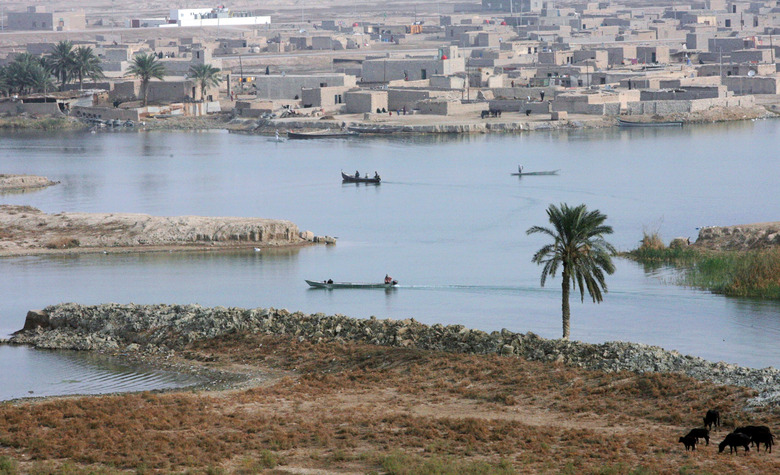Ancient Sumerian Levees & Canals
Canals and levees formed the basis of land irrigation and flood control in ancient Sumer. Located in the lower reaches of the Tigris and Euphrates Rivers in southern Mesopotamia, today's southern Iraq, this is an area of scarce rainfall but major flooding in late winter and spring. From around 3500 B.C. and over the next two millennia, Sumerians pioneered control of the water flow and the development of agriculture whose produce would feed the populations of over 20 city states. However, this process was hampered by increasing salt concentrations in the soil.
Environment and Landscape
Environment and Landscape
The southern Mesopotamian plains where the Sumerians lived appeared flat but like today, constituted a changing landscape. In late winter and spring, snowmelt in the mountains to the north and east brought catastrophic flooding that carried huge quantities of silt and other sediments over more than 1800 kilometers (1118 miles) to the south. Branches of the lower Tigris and Euphrates rivers meandered and merged – anastomosed – over the plains, producing a changing pattern of river levees, turtleback — arched — islands, dune fields and marshes that shifted with the next flood. During the rest of the year, the soil was baked hard and dry by the sun and eroded by the wind.
Levee Construction
Levee Construction
Natural levees are embankments created by deposited river sediments as a river floods. They are asymmetrical structures with almost vertical walls adjacent to the river while tapering landwards along a gentle slope. Levee widths during the Sumerian period were commonly over 1 kilometer (.62 mile). River levels could vary between 4 and 6 meters (13 to 19.7 feet) during flooding. The levee crest could rise up to 10 meters (32.8 feet) above surrounding plains. Sumerians built up the levees by making foundations of reeds impregnated with bitumen, sun-baked surface seepage of crude oil common in the region. Baked mud bricks, also bonded with bitumen, were placed on top of the foundations. This not only increased the height of river banks, it also protected them from erosion by water currents. During dry periods, Sumerians made a simple drainage system by hoisting water in buckets over the levees and watered cultivated land. They also poked holes into the hard and dry levee walls, allowing the water to flow and irrigate crops in adjacent fields.
Canal Construction
Canal Construction
Initially, Sumerians depended on a network of natural, anastomosing river channels for their water supply. They began to dig artificial feeder channels and canals between the third and second millennia B.C., making use of the rivers' avulsions. These are the shifts of water courses created by natural breaks in levee walls, or a weakened part of a levee wall caused by man-made drainage holes. This process caused the water course to split in two. The new river branch either carved an entirely new course or meandered and rejoined the original channel. Sumerians excavated canals along these new water courses and dug smaller feeder channels. They used the excavated soil and debris to construct further levees. The canals could be up to 16 meters (52.5 feet) wide. Water flow was controlled by regulators – dams and sluice gates — erected at points between specially strengthened levee walls. Sumerian farmers faced a constant battle in dredging the canals free from deposited silt.
Salinization Problems
Salinization Problems
Because of their origin as snowmelt, the Tigris and Euphrates river waters have always contained high concentrations of dissolved salts. Over millennia, these salts accumulate in the groundwater and are wicked up to the surface through capillary action in plant roots. Marine transgressions during geological times also left smaller salt accumulations in rocks underlying the soil. Further salt was blown into the Sumerian plains by winds from the Persian Gulf. Rainfall was, and remains, insufficient to flush the groundwater while increased irrigation exacerbates the salinization. Evaporated salt formed a white crust on the surface of fields and levee walls. Modern methods of controlling salt accumulations are by drilling down to the water table and flushing the groundwater. Sumerians didn't have this technology and had to leave fields fallow for alternate years, or abandon them together with the adjacent levees and canals.
Cite This Article
MLA
Kielmas, Maria. "Ancient Sumerian Levees & Canals" sciencing.com, https://www.sciencing.com/ancient-sumerian-levees-canals-16874/. 9 March 2018.
APA
Kielmas, Maria. (2018, March 9). Ancient Sumerian Levees & Canals. sciencing.com. Retrieved from https://www.sciencing.com/ancient-sumerian-levees-canals-16874/
Chicago
Kielmas, Maria. Ancient Sumerian Levees & Canals last modified March 24, 2022. https://www.sciencing.com/ancient-sumerian-levees-canals-16874/
